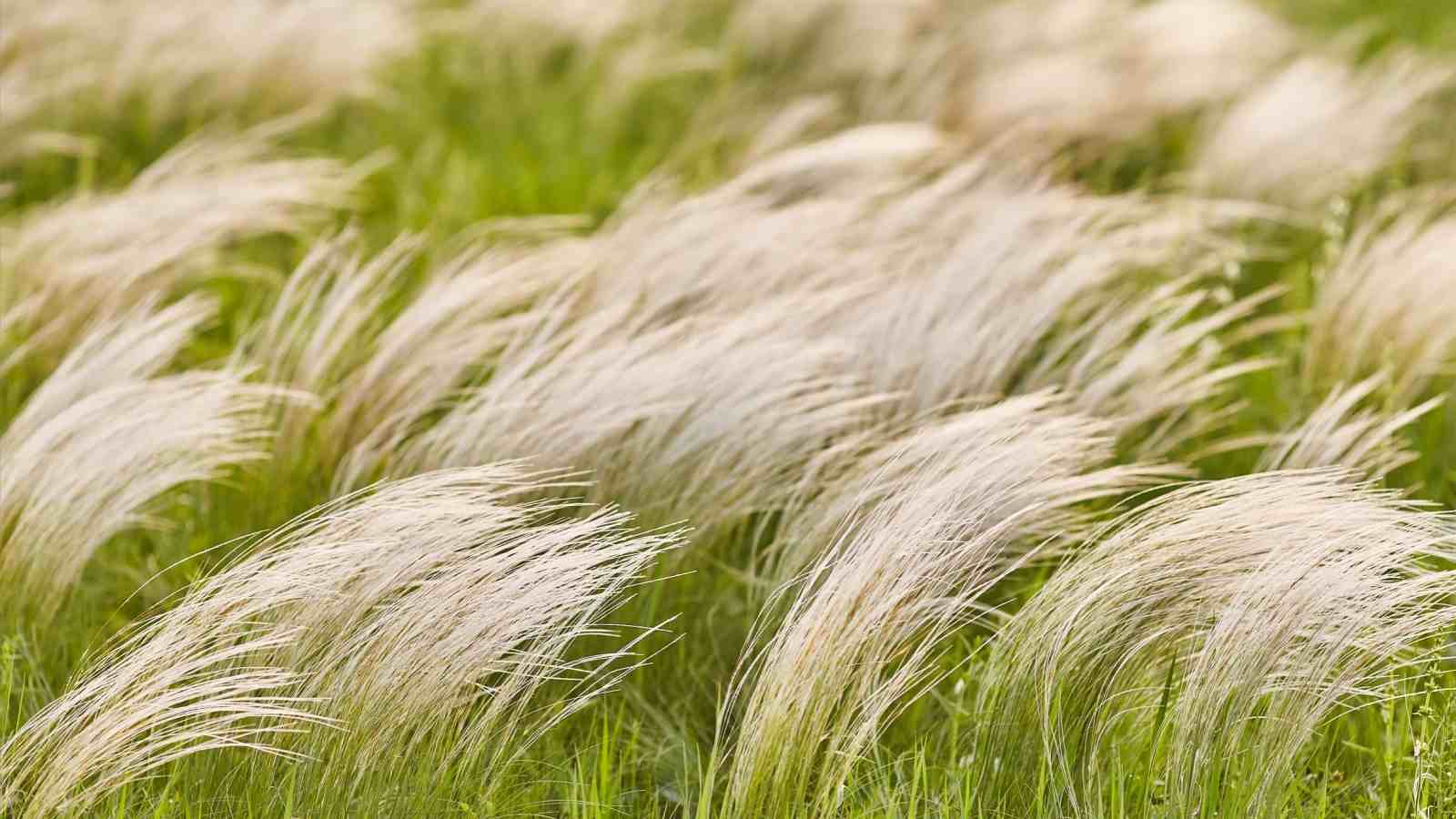Have you ever seen a fine-textured grass field sway gracefully in the slightest breeze, like a shimmering curtain of gold? That might be Mexican feather grass — a captivating ornamental plant that adds elegance to any garden.
If you’re looking for a deer-resistant low-maintenance beauty to improve your landscape, I’ll tell you the basics of what you need to know about growing and maintaining Mexican feather grass.
Basic Information on Mexican Feather Grass
Mexican feather grass is a graceful, perennial ornamental grass known for its delicate flower heads and thin, swaying leaves in the slightest breeze.
This native plant from the drylands of North America and Central Mexico, this perennial grass is well-suited to quick-draining, lean soil and exhibits exceptional drought tolerance. It’s great for erosion control too.
It can grow to a height of 1 to 3 feet and have a width of up to 3 feet.
Mexican feather grass adds movement and texture to gardens. It’s low maintenance and fit for various settings.
However, it can spread quickly in some regions, so gardeners should control its growth if necessary.

How to Care for Mexican Feather Grass
Mexican feather grass produces tan flowers that blooms in the late summer, but I think its main beauty comes from its foliage. It can complement flowering plants and create a multi-seasonal display.
The plant features feathery bright green foliage that remains visually appealing year-round. In colder climates, it is often grown annually. Meanwhile, in warmer zones, it goes dormant in winter and emerges with fresh green growth in spring.
This cool-season grass helps control slope erosion with its dense root system, preventing unwanted washouts.
Light
Mexican feather grass truly comes alive in full sun. Basking in sunlight encourages vibrant growth, with its feathery plumes reaching their full potential.
The sun also intensifies the beautiful color of the foliage, allowing the silvery green or lime-green hues to shine genuinely.
However, I found that it can also survive in part shade, as long as it gets more sun than shade.
Soil and Fertilizer

Mexican feather grass thrives in well-draining, loamy soil. If the soil is rich in clay, I recommend amending it with sand and organic matter to help with the outflow.
A yearly application of compost in spring provides sufficient nutrients for healthy growth, and over-fertilizing should be avoided.
Water
Mexican feather grass is drought-tolerant, so it can survive on minimal watering. That’s because, during dry periods, the grass cleverly copes by entering a state of dormancy, conserving precious resources until rain returns.
Temperature and Humidity
Mexican feather grass can handle hot summers. However, I noticed that it may lose color temporarily in intense heat and humidity.
I’m surprised to find that it also thrives in cold climates and can tolerate temperatures down to around 0°F, but prolonged extreme colds below 0°F can damage or kill the plant.
Pruning
When you grow Mexican feather grass in late fall or early winter, spent flower heads and long stems can be removed to enhance its winter appearance.
I highly recommend using sharp bypass pruners to make clean cuts and remove trimmings to prevent self-seeding.
Propagation

There are two ways to create new Mexican feather grass plants: sowing seeds or division.
Division is best done in early spring before new growth appears. It is a great way to control the size of existing clumps and multiply your plants.
Below are the steps I follow to do this:
- Unearth the Clump: Measure an inch from the outer edge of the mature grass and dig a circle around it, going at least 6 inches deep. Use the shovel to lift the entire clump, including the root ball, gently.
- Divide: Lay the clump on its side and, using the sharp spade, divide it into 2-3 sections depending on its size. Aim for each section to have a healthy portion of roots and foliage.
- Plant Your New Clumps: Pick a new location with well-draining soil and full sun. Dig a hollow twice the size of the root ball of each divided section. Sometimes, I add a layer of compost to the bottom of the hole for extra nourishment.
- Settle In: Place each divided section in its prepared pit, securing the crown (where the stems meet the roots) slightly below the soil surface. Backfill the hollow with soil and water thoroughly.
PRO TIP: Keep the newly divided plants well-watered until they establish themselves, typically within a few weeks.
Potting and Repotting

Mexican feather grass isn’t just for gardens! I also use this graceful grass as a stunning addition to container plantings that you can put on your patio or balcony. Its airy form makes it a perfect centerpiece, adding height and texture to your arrangement.
- Choosing the Right Container: Select a large container with suitable drainage holes. The pot should accommodate the mature size of the grass and its root system. Surround your feather grass with shorter plants that bloom in full sun and well-draining soil. Some good companions include succulents, low-growing perennials like catmint, or colorful annuals.
- Watering Wisely: One key to success is avoiding overwatering. Mexican feather grass prefers to dry out between waterings. Something I do is touch the top inch of the ground. If it feels dry, then I water it.
Overwintering
Mexican feather grass isn’t a fan of cold weather. If you live in an area with freezing temperatures, container-grown plants need special care over winter. Below are some things I do:
- Move Indoors: Bring your container to a frost-free location, like a garage or unheated shed. Provide occasional watering to prevent dry soil.
- Shelter in Place: If relocating isn’t feasible, consider using a cold frame. This unheated structure protects from frost and wind while allowing some light penetration. Water sparingly throughout winter.

There are still some things you can do to keep it healthy throughout the winter:
- In-Ground Plants (Zones 7-10): If you’re in a milder climate (USDA zones 7-10), the grass will survive winter outdoors. However, it may lose some color and go dormant.
- Animal Visitors: Some animals may find the dried foliage attractive for nibbling. You may need to take steps to deter them, such as using chicken wire or a protective mesh.
Common Mexican Feather Grass Problems

I love Mexican feather grass since it’s low-maintenance and resistant to pests (like aphids and leaf spot) and diseases. It also isn’t bothered by deer and rabbits. However, a few things must be considered to ensure it thrives in your garden.
- Overenthusiastic Spreader: This plant can become overly ambitious and crowd out its neighbors. To prevent this, manually remove unwanted clumps in spring before new growth appears. Alternatively, consider using herbicides for very stubborn cases.
- Infertile Option: If the spreading nature is a concern, opt for sterile cultivars from nurseries. These varieties produce non-viable seeds, limiting their invasiveness.
- Falling Flat (Lodging): Several factors can cause your Mexican feather grass to lean or fall over.
- Thirsty Grass: Ensure proper watering during the growing season, but avoid soggy soil as it can cause root rot.
- Too Much Feasting: Limit fertilizer application to once a year, preferably in spring. Overfertilization, especially with nitrogen-rich fertilizers, can contribute to lodging.
- Time for a Cut: If the clumps become dense or overgrown (usually after three years), consider dividing them to promote better air circulation and prevent lodging.
- Natural Dormancy: During cooler weather, the tip of the feather grass turns brown as it enters its natural dormancy period. This is nothing to worry about.
- Early Summer Scorch: Brown tips during the growing season could indicate insufficient watering or excessive heat stress. Ensure your plant receives adequate water, especially during hot spells.
By following my tips, you can enjoy the beauty of Mexican feather grass while keeping it healthy and under control in your garden.
How to Get Rid of Mexican Feather Grass

As I’ve mentioned, Mexican feather grass can be an invasive plant if not controlled.
Glyphosate and hexazinone are two effective herbicide options for eliminating individual Mexican feather grass plants.
- Foliar Spray: Apply 1.5% glyphosate directly to the leaves.
- Soil Application: Apply 2 ml of hexazinone around the base of the plant.
Here are some important considerations to take note:
- Multiple treatments may be necessary for complete control.
- Always follow the legal restrictions on herbicide use in your area. These regulations typically specify the maximum amount of chemicals allowed per treated area in a year.
Other Guides from Planet Natural:











